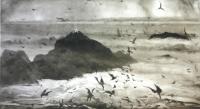Aquatint

This technique is so called because the finished prints often resemble water colours. It is a method used by many printmakers to achieve a wide range of tonal values.
The technique requires the application of a resin powder to the plate which is then heated and then put in a bath of acid. The acid bites the plate only in the spaces between the resin particles, achieving a finely and evenly pitted surface that yields broad areas of tone when the grains are washed off and the plate is now ready for the artist to work on.
Many tones can be achieved on a single plate by exposing different areas to different acid concentrations or different exposure times. The acid bites around each grain of the resin, creating a tooth in the plate to hold ink. The deeper the bite, the more ink is held in the plate and the darker the tones will be in the print.
Aquatint techniques are often used in combination with etching or engraving to achieve a combination of line and tone.
Aquatint only really came to favour after Francisco Goya used it to such great effect in his celebrated etchings entitled Los Caprichos. Since then it has been more widely used and adopted by many great artists including Edgar Degas and Camille Pissarro.